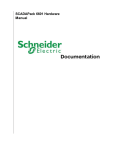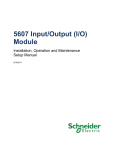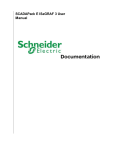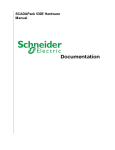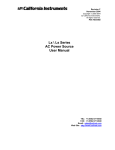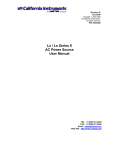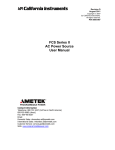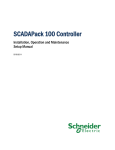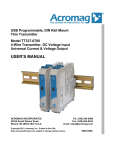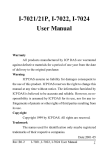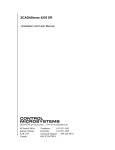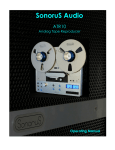Download SCADAPack E 5607 I/O Hardware Manual
Transcript
SCADAPack E 5607 Input/Output Module Hardware Manual Version: 8.14.3 Date: August 2017 Table of Contents 1 Legal Information .....................................................................................................................................................6 2 Technical Support .....................................................................................................................................................7 3 Safety Information .....................................................................................................................................................8 4 Documentation Check .....................................................................................................................................................11 5 About this Manual .....................................................................................................................................................13 6 About the 5607 I/O Expansion Module .....................................................................................................................................................15 7 Hardware Overview .....................................................................................................................................................18 7.1 Power ............................................................................................................................................18 Supply 7.2 Digital ............................................................................................................................................18 Inputs and Outputs 7.3 7.4 8 7.2.1 Digital..........................................................................................................................18 Inputs 7.2.2 Digital..........................................................................................................................18 Outputs Analog ............................................................................................................................................18 Inputs 7.3.1 Current ..........................................................................................................................18 or Voltage Mode 7.3.2 Range..........................................................................................................................18 and Resolution Analog ............................................................................................................................................18 Outputs 7.4.1 Current ..........................................................................................................................18 and Voltage Outputs 7.4.2 Range..........................................................................................................................18 and Resolution Installation .....................................................................................................................................................26 8.1 For ............................................................................................................................................26 ATEX and IECEx Applications Only 8.2 System ............................................................................................................................................26 Grounding 8.3 Mounting ............................................................................................................................................26 the I/O Module 8.4 Power ............................................................................................................................................26 Supply Requirements 8.5 Power ............................................................................................................................................26 Supply Wiring 8.6 8.5.1 Recommended ..........................................................................................................................26 24 Vdc Power Supply Configuration 8.5.2 Recommended ..........................................................................................................................26 Battery Configuration 8.5.3 Recommended ..........................................................................................................................26 5103 Power Supply Configuration Connecting ............................................................................................................................................26 I/O Expansion Modules 8.6.1 2 Precautions ..........................................................................................................................26 9 10 8.6.2 Connection ..........................................................................................................................26 Rules 8.6.3 Attaching ..........................................................................................................................26 Intermodule Cables Addressing .....................................................................................................................................................42 9.1 Addressing ............................................................................................................................................42 Rules 9.2 Setting ............................................................................................................................................42 the I/O Expansion Module Address Field Wiring .....................................................................................................................................................46 10.1 Wiring ............................................................................................................................................46 Screw-Termination Connectors 10.2 Digital ............................................................................................................................................46 Input Wiring 10.2.1 Digital..........................................................................................................................46 Input Wiring Example 10.3 Digital ............................................................................................................................................46 Output Wiring 10.3.1 Digital..........................................................................................................................46 Output Wiring Example 10.4 Analog ............................................................................................................................................46 Input Wiring 10.4.1 Analog ..........................................................................................................................46 Input Wiring Example 10.4.2 Configuring ..........................................................................................................................46 Analog Inputs as Current Inputs 10.4.3 Helping ..........................................................................................................................46 to Prevent Interruption of the Current Loop 10.5 Analog ............................................................................................................................................46 Output Wiring 10.5.1 Analog ..........................................................................................................................46 Output Wiring Example 10.5.2 Analog ..........................................................................................................................46 Output Power Supply Configuration Options 11 Configuration .....................................................................................................................................................66 11.1 SCADAPack ............................................................................................................................................66 E Configurator 11.2 Reading ............................................................................................................................................66 and Writing Data with Logic Programs 12 Diagnostics .....................................................................................................................................................69 12.1 LEDs ............................................................................................................................................69 12.2 Digital ............................................................................................................................................69 Inputs 12.3 Digital ............................................................................................................................................69 Outputs 12.4 Analog ............................................................................................................................................69 Inputs 12.5 Analog ............................................................................................................................................69 Outputs 13 Calibration .....................................................................................................................................................72 14 Maintenance .....................................................................................................................................................73 15 Specifications .....................................................................................................................................................74 15.1 General ............................................................................................................................................74 3 15.2 Power ............................................................................................................................................74 Supply 15.3 Digital ............................................................................................................................................74 Inputs 15.4 Digital ............................................................................................................................................74 Outputs 15.5 Analog ............................................................................................................................................74 Inputs 15.6 Analog ............................................................................................................................................74 Outputs 16 4 Standards and Certifications .....................................................................................................................................................82 5607 Input/Output Module Hardware Manual 8.14.3 5 Legal Information 1 5607 Input/Output Module Hardware Manual Legal Information The information provided in this documentation contains general descriptions and/or technical characteristics of the performance of the products contained herein. This documentation is not intended as a substitute for and is not to be used for determining suitability or reliability of these products for specific user applications. It is the duty of any such user or integrator to perform the appropriate and complete risk analysis, evaluation and testing of the products with respect to the relevant specific application or use thereof. Neither Schneider Electric nor any of its affiliates or subsidiaries shall be responsible or liable for misuse of the information contained herein. If you have any suggestions for improvements or amendments or have found errors in this publication, please notify us. No part of this document may be reproduced in any form or by any means, electronic or mechanical, including photocopying, without express written permission of Schneider Electric. All pertinent state, regional, and local safety regulations must be observed when installing and using this product. For reasons of safety and to help ensure compliance with documented system data, only the manufacturer should perform repairs to components. Trademarks Schneider Electric, ClearSCADA, SCADAPack, Trio, Modbus, and StruxureWare are trademarks and the property of Schneider Electric SE, its subsidiaries and affiliated companies. All other trademarks are the property of their respective owners. Address Schneider Electric 415 Legget Drive, Suite 101, Kanata, Ontario K2K 3R1 Canada Direct Worldwide: +1 (613) 591-1943 Fax: +1 (613) 591-1022 Toll Free within North America: 1 (888) 267-2232 www.schneider-electric.com © 2014 - 2017 Schneider Electric Canada Inc. All rights reserved. 6 8.14.3 5607 Input/Output Module Hardware Manual 2 Technical Support Technical Support Questions and requests related to any part of this documentation can be directed to one of the following support centers. Technical Support: Americas, Europe, Middle East, Asia Available Monday to Friday 8:00am – 6:30pm Eastern Time Toll free within North America 1-888-226-6876 Direct Worldwide +1-613-591-1943 Email [email protected] Technical Support: Australia 8.14.3 Inside Australia 1300 369 233 Email [email protected] 7 Safety Information 3 5607 Input/Output Module Hardware Manual Safety Information Important Information Read these instructions carefully and look at the equipment to become familiar with the device before trying to install, operate, service, or maintain it. The following special messages may appear throughout this documentation or on the equipment to warn of potential hazards or to call attention to information that clarifies or simplifies a procedure. The addition of this symbol to a Danger or Warning safety label indicates that an electrical hazard exists, which will result in personal injury if the instructions are not followed. This is the safety alert symbol. It is used to alert you to potential personal injury hazards. Obey all safety messages that follow this symbol to avoid possible injury or death. DANGER DANGER indicates a hazardous situation which, if not avoided, will result in death or serious injury. WARNING WARNING indicates a hazardous situation which, if not avoided, can result in death or serious injury. CAUTION CAUTION indicates a potentially hazardous situation which, if not avoided, can result in minor or moderate injury. NOTICE NOTICE is used to address practices not related to physical injury. 8 8.14.3 5607 Input/Output Module Hardware Manual Safety Information Please Note Electrical equipment should be installed, operated, serviced, and maintained only by qualified personnel. No responsibility is assumed by Schneider Electric for any consequences arising out of the use of this material. A qualified person is one who has skills and knowledge related to the construction, installation, and operation of electrical equipment and has received safety training to recognize and avoid the hazards involved. Before You Begin Do not use this product on machinery lacking effective point-of-operation guarding. Lack of effective pointof-operation guarding on a machine can result in serious injury to the operator of that machine. WARNING EQUIPMENT OPERATION HAZARD · Verify that all installation and set up procedures have been completed. · Before operational tests are performed, remove all blocks or other temporary holding means used for shipment from all component devices. · Remove tools, meters, and debris from equipment. Failure to follow these instructions can result in death or serious injury. Follow all start-up tests recommended in the equipment documentation. Store all equipment documentation for future reference. Test all software in both simulated and real environments. Verify that the completed system is free from all short circuits and grounds, except those grounds installed according to local regulations (according to the National Electrical Code in the U.S.A, for instance). If high-potential voltage testing is necessary, follow recommendations in equipment documentation to help prevent accidental equipment damage. Operation and Adjustments The following precautions are from the NEMA Standards Publication ICS 7.1-1995 (English version prevails): · Regardless of the care exercised in the design and manufacture of equipment or in the selection and ratings of components, there are hazards that can be encountered if such equipment is improperly operated. · It is sometimes possible to misadjust the equipment and thus produce unsatisfactory or unsafe operation. Always use the manufacturer’s instructions as a guide for functional adjustments. Personnel who have access to these adjustments should be familiar with the equipment manufacturer’s instructions and the machinery used with the electrical equipment. · Only those operational adjustments actually required by the operator should be accessible to the operator. Access to other controls should be restricted to help prevent unauthorized changes in operating characteristics. 8.14.3 9 Safety Information 5607 Input/Output Module Hardware Manual Acceptable Use SCADAPack E remote Programmable Automation Controllers (rPACs), Remote Terminal Units (RTUs) and input/output (I/O) modules are intended for use in monitoring and controlling non-critical equipment only. They are not intended for safety-critical applications. WARNING UNACCEPTABLE USE Do not use SCADAPack E rPACs, RTUs, or I/O modules as an integral part of a safety system. These devices are not safety products. Failure to follow this instruction can result in death or serious injury. CAUTION EQUIPMENT OPERATION HAZARD When devices are used for applications with technical safety requirements, the relevant instructions must be followed. Use only Schneider Electric software or approved software with Schneider Electric hardware products. Failure to follow these instructions can result in minor or moderate injury. 10 8.14.3 5607 Input/Output Module Hardware Manual 4 Documentation Check Documentation Check Before you begin installation, verify that you are viewing the correct documentation. If your I/O expansion module looks like this (with green connectors and a black circuit board), continue with this manual. SCADAPack 5607 I/O Expansion Module If your I/O expansion module looks like this (with grey connectors and a green circuit board), you will need to get the legacy hardware manual. To access the legacy hardware manual, select the Start or Windows icon, then navigate to the Schneider Electric folder and select SCADAPack E > User and Reference Manuals > Legacy Hardware Manuals. 8.14.3 11 Documentation Check 5607 Input/Output Module Hardware Manual SCADAPack 5607 I/O Expansion Module (Previous Version) 12 8.14.3 5607 Input/Output Module Hardware Manual 5 About this Manual About this Manual Audience This manual is written for people who need to install, troubleshoot or maintain the Remote Terminal Unit (RTU) hardware. These individuals are typically: · Systems Engineers · Commissioning Engineers · Maintenance Technicians Scope This manual describes: · The physical design of the I/O expansion module, including detailed hardware specifications · Installation, wiring and addressing for the I/O expansion module · Diagnostics capabilities available on the I/O expansion module · Maintenance recommendations for the I/O expansion module Product Related Information WARNING UNINTENDED EQUIPMENT OPERATION The application of this product requires expertise in the design and programming of control systems. Only persons with such expertise should be allowed to program, install, alter and apply this product. Follow all local and national safety codes and standards. Failure to follow these instructions can result in death or serious injury. Related Documents Use this manual with other manuals included in your SCADAPack E documentation set. The table below lists the main manuals for the tasks described. However, it is not a complete list of the manuals available to you. Please see the SCADAPack E Reference Manual set for a complete listing of manuals. 8.14.3 For Information About See Using the I/O expansion module with your Remote Terminal Unit (RTU). I/O Expansion Technical Reference Manual The Hardware Manual for the RTU to which this I/O expansion module is connected. 13 About this Manual Configuring I/O expansion module inputs and outputs 14 5607 Input/Output Module Hardware Manual SCADAPack E Configurator User Manual Configuration Technical Reference Manual 8.14.3 5607 Input/Output Module Hardware Manual 6 About the 5607 I/O Expansion Module About the 5607 I/O Expansion Module The 5607 I/O expansion module provides: · 16 digital inputs · 10 relay digital outputs · 8 analog inputs · 2 analog outputs (this option is selected when the module is ordered) The 5607 I/O module is available as a standalone unit that can be added to the I/O expansion bus for the following RTUs: · SCADAPack 312E · SCADAPack 313E · SCADAPack 314E · SCADAPack 330E · SCADAPack 333E · SCADAPack 334E · SCADAPack 337E · SCADAPack 350E · SCADAPack 357E A maximum of eight (8) individually addressed 5607 modules can be added to the I/O expansion bus. It is important to consider the power requirements of the 5607. You may need to add a 5103 power supply module. Refer to the RTU manual for details. This manual covers the powering, wiring and configuration of a 5607 I/O module only. It is meant to be used with the hardware manual of the respective RTU to which it is connected. The 5607 I/O expansion module is shown in the image below: 8.14.3 15 About the 5607 I/O Expansion Module 5607 Input/Output Module Hardware Manual Connections The I/O expansion module includes a short intermodule cable for connecting to an RTU or to another I/O expansion module. For information about the maximum number of expansion modules supported, see the Specifications. For details on connecting I/O expansion modules, see Connecting I/O Expansion Modules 36 . Screw-termination connectors are provided for connecting the inputs and outputs to the devices you want to monitor or control. For details on wiring input and output connectors, see Wiring Screw-Termination Connectors 49 . Configuration You can configure the I/O expansion module inputs and outputs using one of three methods: · Locally or remotely using SCADAPack E Configurator, a software application that runs on a desktop or laptop computer connected to the RTU through the USB device port or through any of the available serial ports or Ethernet port. · Remotely as part of an end-to-end SCADA system using the StruxureWare SCADA Expert 16 8.14.3 5607 Input/Output Module Hardware Manual About the 5607 I/O Expansion Module ClearSCADA software. · Locally using applications created in the SCADAPack Workbench or ISaGRAF 3 Workbench user programming tools. Typically, applications created in these tools extend and enhance the functionality provided by the I/O expansion module. However, you can also write applications that replace the configuration functionality provided through the SCADAPack E Configurator software or the SCADA Expert ClearSCADA software. Before you begin configuring the inputs and outputs on the I/O expansion module, determine whether the ClearSCADA software will be used for any configuration tasks. This documentation assumes you are using the SCADAPack E Configurator software to configure the I/O expansion module. For information about using the ClearSCADA software, see the ClearSCADA documentation. 8.14.3 17 Hardware Overview 7 5607 Input/Output Module Hardware Manual Hardware Overview The figure below shows the locations of the inputs and outputs on the device. The following table describes input and output characteristics. The inputs and outputs use 5 mm (0.197 in.) pitch connectors. See the Specifications 74 section for the recommended wire sizes. 18 8.14.3 5607 Input/Output Module Hardware Manual Input/Output Type Description Digital inputs 16 digital inputs 21 Hardware Overview Optically isolated from logic power Wired to connectors P5 and P8 Digital outputs 21 10 dry contact, digital (mechanical relay) or solid state relay (SSR) outputs Wired to connector P7 Analog inputs 21 8 analog inputs Wired to connector P4 Analog outputs 23 2 analog outputs (optional) Wired to connector P3 12-bit, unipolar, digital to analog (D/A) converter Input power 20 11...30 Vdc input power Wired to connector P3 8.14.3 19 Hardware Overview 7.1 5607 Input/Output Module Hardware Manual Power Supply The I/O expansion module is powered primarily by the 11...30 Vdc power supply of the RTU. The analog inputs and optional analog outputs (where available), require an external 12 Vdc or 24 Vdc power supply connected to the input power supply of the I/O expansion module. For further information, see the Power Supply Wiring 33 section. 7.2 Digital Inputs and Outputs The 5607 I/O module expands the function of the RTU with 16 digital inputs and 10 dry contact (mechanical) relay or solid state relay (SSR) outputs. Digital inputs and outputs can be used to monitor or control panel lamps, relays, motor starters, solenoid valves, and other devices. Digital inputs are available for nominal 12...24 Vdc operation. A current-limiting resistor on each input determines the voltage range. The relay outputs are suited to applications that cannot tolerate any off-state leakage current, that require high load currents, or that involve non-standard voltages or current ranges. Configuration Using the SCADAPack E Configurator software, you can configure each input or output to define its characteristics, including: · DNP3 attributes · Point state · Remote control interlock attributes · Event attributes · Alarm and trend attributes · Properties · Debounce time (inputs) · Output pulse time (outputs) For more information about configuring digital inputs and outputs, see the SCADAPack E Configurator User Manual and the Configuration Technical Reference Manual. Specifications For digital input and output specifications, see Specifications Digital Inputs 74 . 21 Digital Outputs 21 Wiring Digital inputs and outputs support solid or stranded wires from 3.3...0.08 mm2 (12...28 AWG). For more information, see Wiring Screw-Termination Connectors 20 49 . 8.14.3 5607 Input/Output Module Hardware Manual 7.2.1 Hardware Overview Digital Inputs The I/O module expands the function of the RTU with 16 digital inputs. The digital inputs are optically isolated from the logic power and are available in 12 or 24 Vdc voltage ranges. A current limiting resistor, on each input, determines the voltage range. Light Emitting Diodes (LED) on the digital inputs show the status of each of the input. The digital input LEDs can be disabled to conserve power. To simplify field wiring, the 16 inputs are organized into two groups of eight inputs. Each group shares a common return. These groups of eight inputs are isolated from each other. Inputs 0 to 7 are in one group. Inputs 8 to 15 are in another group. 7.2.2 Digital Outputs The 5607 I/O module expands the function of the RTU with 10 digital outputs. NOTICE UNINTENDED EQUIPMENT OPERATION Incandescent lamps and other loads may have inrush currents that will exceed the rated maximum current of the relay contacts. This inrush current may damage the relay contacts. Interposing relays need to be used in these situations. Failure to follow these instructions can result in equipment damage. The 10 digital outputs are either dry contact (mechanical) relay or solid state relay (SSR) outputs. Outputs are Form A (normally open NO). Loads can be connected to either output terminal and to either the high or the low side of the power source. Light Emitting Diodes (LEDs) on the digital outputs show the status of each of the outputs. The digital output LEDs can be disabled to conserve power. 7.3 Analog Inputs The I/O module enhances the capacity of an RTU by providing 8 additional single-ended analog inputs on connector P4 that can be configured for current or voltage mode. The analog inputs are used to monitor devices such as pressure, level, flow, and temperature transmitters, instrumentation such as pH and conductivity sensors, and other high-level analog signal sources. Analog inputs can be individually configured for input mode — current or voltage — and range. Refer to Current or Voltage Mode 22 for information on how to choose input modes. The analog inputs use a 16-bit successive approximation digital to analog (D/A) converter. Configuration Using the SCADAPack E Configurator software, you can configure each analog input to define its characteristics, including: · DNP3 attributes · Current values · Scaling 8.14.3 21 Hardware Overview 5607 Input/Output Module Hardware Manual · Alarm and trend attributes · Value deviation · Properties For more information about configuring analog inputs, see the SCADAPack E Configurator User Manual and the Configuration Technical Reference Manual. Specifications For analog input specifications, see Specifications Current or Voltage Mode Range and Resolution 74 . 22 22 Wiring Analog inputs support solid or stranded wires from 3.3...0.08 mm2 (12...28 AWG). For more information, see Wiring Screw-Termination Connectors 7.3.1 49 . Current or Voltage Mode The analog inputs can be configured for either voltage or current mode via SCADAPack E Configurator. · In current mode, a 250-ohm current sense resistor appears across each analog input channel. Measurement range in current mode is 0...20 mA or 4...20 mA, selectable via software. The 250ohm resistor produces a voltage drop (input reading) of 5 Vdc for 20 mA of current flow. · In voltage mode, analog inputs are single-ended with a measurement range of 0...5 Vdc or 0...10 Vdc. NOTICE UNINTENDED EQUIPMENT OPERATION This module must be the only loop current measurement device in the loop when using the analog inputs in the 20 mA measurement mode. If power to the module is removed, the module reverts to voltage mode and results in an open current loop. Applications that cannot tolerate this possibility require external current sense resistors, with the module input range set to voltage. Failure to follow these instructions can result in equipment damage. 7.3.2 Range and Resolution The analog inputs have a 16-bit, unipolar, analog to digital (A/D) converter that measures input voltages from 0...5 Vdc or 0...10 Vdc. The analog inputs are factory-calibrated to scale the data and represent it with a 16-bit signed number. 22 8.14.3 5607 Input/Output Module Hardware Manual Hardware Overview When assigning RTU database points to the module channels using SCADAPack E Configurator, the user configures the input type signal range for each analog input channel. The following input type ranges can be configured for each analog input channel: · 0...5 Vdc · 0...10 Vdc · 0...20 mA · 4...20 mA The input type range selected is scaled to the Raw Min. to Raw Max. range configured for the individual analog input point when point integer values are used. The Eng. Min. to Eng. Max. range for the point is used to scale the analog input Engineering Floating Point database value. For example, if an analog input point's attributes are RAW_MIN = 0, RAW_MAX = 10000 and the input channel is selected for 4...20 mA, a 20 mA input is 100% of the selected input signal range and corresponds to 10000 counts. A 4 mA input is 0% of the selected input signal range and corresponds to 0 counts. The following table shows the analog input values and status for several input signals. Over and under range status detection occurs when the measured input is outside of the measurement range by greater than 0.2%. 0...5 Vdc Range (Vdc) 0...10 Vdc Range (Vdc) 4...20 mA Range (mA) 0...20 mA Point database Over or under Range (mA) value range status* N/A N/A <3.968 N/A under-range ON 0 0 4 0 RAW_MIN OFF ENG_MIN 1.25 2.5 8 5 25% of scale OFF 2.5 5.0 12 10 50% of scale OFF 3.75 7.5 16 15 75% of scale OFF 5 10 20 20 RAW_MAX OFF ENG_MAX 5.0024 10.0048 20.032 20.01 over-range ON * Under-range and over-range point status may also be asserted by SCADAPack E Analog Input Point configuration parameters. For more information see the SCADAPack E I/O Expansion Technical Reference Manual and the SCADAPack E Data Processing Technical Reference Manual. 7.4 Analog Outputs Analog outputs are used to control remote devices that require varying input information, rather than simple on or off operations. 8.14.3 23 Hardware Overview 5607 Input/Output Module Hardware Manual The optional analog outputs are ordered at the time of purchase. The analog output channels are powered with an external 12 Vdc or 24 Vdc power supply. They can be configured for 0...20 mA or 4...20 mA current. Configuration Using the SCADAPack E Configurator software, you can configure each analog output to define its characteristics, including: · DNP3 attributes · Current values · Scaling · Trend inhibit state · Value deviation · Properties For more information about configuring analog outputs, see the SCADAPack E Configurator User Manual and the Configuration Technical Reference Manual. Specifications For analog output specifications, see Specifications Current and Voltage Outputs Range and Resolution 74 . 24 25 Wiring Analog outputs support solid or stranded wires from 3.3...0.08 mm2 (12...28 AWG). For more information, see Wiring Screw-Termination Connectors 7.4.1 49 . Current and Voltage Outputs Current Outputs The I/O expansion module can be equipped with an optional 5305 analog output module that provides two 20 mA analog outputs. Analog output resolution is 12 bits. The outputs provide a level of transient and over-voltage protection. The outputs share a common return with each other and with the analog inputs. See Analog Output Wiring 64 for an illustration on how to connect current outputs. Voltage Outputs To obtain voltage outputs, connect a load resistor as shown in Analog Output Wiring voltage device across the load resistor. 64 and connect the The table below lists resistance values and output range settings for common voltage ranges. The resistance value listed is the parallel resistance of the device and the load resistor. 24 8.14.3 5607 Input/Output Module Hardware Manual Hardware Overview Resistance Output Range Voltage Range 250 ohms 0...20 mA 0...5 Vdc 4...20 mA 500 ohms 7.4.2 0...20 mA 0...10 Vdc Range and Resolution The optional analog output module installed on the I/O expansion module has a 12-bit, unipolar, digital to analog (D/A) converter. One of the following output type ranges can be configured on SCADAPack E Configurator I/O > SCADAPack I/O page for the I/O expansion module. Both analog output channels use the same range: · 0...20 mA · 4...20 mA The 0...20 mA output range resolution is 4.88 µA per D/A count. Configuration for points attached to the optional analog output channels uses the SCADAPack E Raw Min. to Raw Max. and Eng. Min. to Eng. Max. parameters for integer and engineering scaling, respectively. These scaling ranges automatically apply to the analog output signal range selected by SCADAPack E Configurator for the analog output type (0...20 mA or 4...20 mA). 8.14.3 25 Installation 8 5607 Input/Output Module Hardware Manual Installation The topics in this section describe how to mount the I/O expansion module, power it, and connect it to the system I/O bus. The following diagram shows the dimensions of the I/O expansion module. For more information, see: For ATEX and IECEx Applications Only Mounting the I/O Module 29 Power Supply Requirements Power Supply Wiring 32 33 Connecting I/O Modules 26 27 36 8.14.3 5607 Input/Output Module Hardware Manual 8.1 Installation For ATEX and IECEx Applications Only Provide overvoltage protection external to the equipment. The rated supply cable temperature is 105 °C. Consider the instructions in the warning message below when installing the I/O expansion module. WARNING EXPLOSION HAZARD · Only install this equipment under the following conditions: Conditions of Safe Use · Only use this equipment in an area not exceeding pollution degree 2, as defined in EN/IEC 60664-1. · Install this equipment in an enclosure certified for use, that is tool accessible only and provides a degree of protection of IP54 or better, in accordance with EN 60079-15. · Provide transient protection at a level that does not exceed 140% of the peak rated voltage value at the supply terminals to the equipment. · The free internal volume of the enclosure must be dimensioned in order to keep the temperature rating. · For products using solid state relays (5606 and 5607 I/O modules and RTUs using these modules), a T4 rating is acceptable for maximum loads of 1.33 A. When 2 A loads are connected to the solid state relays, the maximum ambient rating is lowered to 50 °C (122 ºF) in order to maintain the T4 rating. Failure to follow these instructions can result in death or serious injury. The following product label appears on your 5607 I/O expansion module: 8.14.3 27 Installation 8.2 5607 Input/Output Module Hardware Manual System Grounding Ground the system by connecting the system power supply common to the chassis or panel ground. The negative (-) side of the DC power input terminal as well as I/O point terminals labeled COM are connected to chassis ground. RTUs and I/O expansion modules are mounted on a DIN rail which is connected to the panel as shown in the illustration below. Connect the panel to ground according to the local electrical code. 28 8.14.3 5607 Input/Output Module Hardware Manual 8.3 Installation Mounting the I/O Module The I/O expansion module mounts on a 7.5 x 35 mm (0.3 x 1.4 in) DIN rail. WARNING UNINTENDED EQUIPMENT OPERATION Evaluate the operational state of the equipment being monitored or controlled by the SCADAPack E RTU and the I/O expansion module before removing power. Failure to follow these instructions can result in death or serious injury. WARNING ELECTRICAL HAZARD Remove power from the I/O expansion module before mounting it on a DIN rail. Do not remove the I/O expansion module cover when mounting the module. The I/O expansion module is designed so that it can be mounted on a DIN rail with the cover in place. Failure to follow these instructions can result in death or serious injury. NOTICE UNINTENDED EQUIPMENT OPERATION Installing the I/O expansion module in an environment where the electromagnetic compatibility (EMC) rating exceeds the certified EMC rating for the I/O expansion module can lead to unpredictable operation and unexpected results. Failure to follow these instructions can result in equipment damage. 8.14.3 29 Installation 5607 Input/Output Module Hardware Manual To Mount the I/O Expansion Module on a DIN Rail The illustrations in this procedure show the correct way to mount the device on a horizontally oriented DIN rail. The steps to mount the device on a vertically oriented DIN rail are the same. Your device may look different from the device shown in the illustrations. 1. With the lower part of the device tilted away from the DIN rail, position the mounting guide line on the side of the device so that it is just above the edge of the DIN rail. The springs on the back of the device should rest on the DIN rail and the edge of the DIN rail should be under the support claws that are adjacent to the springs, as shown below. 2. Push firmly on the device while tilting it toward the DIN rail until the DIN rail is positioned under both the upper and lower claws on the back of the device. 3. Release the pressure on the springs so that the DIN rail is held firmly in place between the upper and lower claws. The mounting guide line should be aligned with the edge of the DIN rail. The figure below shows a device with the DIN rail correctly positioned in the upper and lower claws on the back of the device. 30 8.14.3 5607 Input/Output Module Hardware Manual Installation The figure below shows the front view of a device that is mounted on a horizontally oriented DIN rail. 8.14.3 31 Installation 8.4 5607 Input/Output Module Hardware Manual Power Supply Requirements Analog outputs are not included in this calculation. Add 20 mA for each analog output used. The power requirement of the I/O module is summarized in the table below: 32 Digital Output Relays LEDs Digital Inputs 24 Vdc 5 Vdc Current Required from the RTU On On On 2.6 W 400 mA 8.14.3 5607 Input/Output Module Hardware Manual 8.5 Installation Power Supply Wiring The I/O board requires a nominally 12 Vdc or 24 Vdc power supply applied to the terminals labeled 11...30 Vdc on connector P3 to power the analog input and optional analog output circuitry. The current requirement of the analog portion (input and optional output circuitry) on the I/O board can vary from a minimum of 12 mA for basic operation of the analog circuitry plus an additional 40 mA for the optional analog outputs. In addition, the system controller or power supply provides 5 Vdc through the I/O Bus cable. Refer to the Specifications 74 section of the RTU manual for its power capabilities. A sample power calculation for a SCADAPack RTU with an integrated I/O board can be found in the manual of the corresponding RTU. See the image below for the location of the input power connection. Power for the I/O board can be provided in several ways: · With a 24 Vdc source connected to the PWR IN terminals on the controller board and on the I/O board in a parallel configuration. See Recommended 24 Vdc Power Supply Configuration 34 for an 8.14.3 33 Installation 5607 Input/Output Module Hardware Manual example of this wiring configuration. · With a 12 Vdc source connected to the PWR IN terminals on the controller board and on the I/O board in a parallel configuration. See Recommended Battery Configuration 35 for an example of this wiring configuration. · With a 5103 Uninterruptible Power Supply (UPS) providing 5 Vdc to the controller board through the IMC cable and 24 Vdc to the I/O board through the 24 Vdc output. See Recommended 5103 Power Supply Configuration 36 for an example of this wiring configuration. For information about grounding the system, see System Grounding 8.5.1 28 . Recommended 24 Vdc Power Supply Configuration This configuration uses a 24 Vdc power supply to power the RTU and the I/O board or I/O expansion module. This 24 Vdc is also used to power the analog circuitry on the I/O board or the I/O expansion module. · This configuration is recommended when a large amount of current is required at 24 Vdc. Refer to the Specifications 74 section. · Connect the controller board PWR IN terminal to the same power supply as the I/O board or I/O expansion module PWR IN terminal. 34 8.14.3 5607 Input/Output Module Hardware Manual 8.5.2 Installation Recommended Battery Configuration This configuration uses a 12 V battery to power the RTU and the I/O board or I/O expansion module. This 12 V battery is also used to power the analog circuitry for the analog inputs and optional analog outputs (where available) on the I/O board or I/O expansion module. · This configuration is recommended when a large amount of current is required at 12 Vdc. Refer to the Specifications 74 section for power requirements from a 12 V battery. · Connect the RTU PWR IN terminal to the same power supply as the I/O board or I/O expansion module PWR IN terminal. 8.14.3 35 Installation 8.5.3 5607 Input/Output Module Hardware Manual Recommended 5103 Power Supply Configuration When additional power is required by the system, 5103 power supplies can be used in combination with the RTU. The 5103 power supplies can be connected anywhere downstream (to the right) of the RTU. They supply power to the modules that are downstream from them. The 5103 power supply can also be connected upstream (to the left) of the RTU, but only if the following conditions are met: · No power is applied to the power inputs of the controller board · A jumper is installed at position J5 This configuration uses a 5103 Uninterruptible Power Supply (UPS) to power an RTU. The 24 Vdc output from the 5103 powers the I/O board. The 5103 power supply provides a 5 Vdc output to power the I/O board, the RTU and any additional 5000 series modules through the intermodule cables. No connection is made to the PWR IN terminals on the RTU. The diagram below is representational, meant to illustrate the power connections of the devices. 8.6 Connecting I/O Expansion Modules The topics in this section describe how to attach I/O expansion modules to an rPAC or RTU, or to another I/O expansion module. I/O expansion modules are mounted on a 7.5 x 35 mm (0.3 x 1.4 in) DIN rail then connected to an rPAC or RTU using intermodule cables. The intermodule cable is a ribbon cable that distributes power and communications signals from the rPAC or RTU to the I/O expansion modules. These power and communication signals are referred to as the I/O bus. 36 8.14.3 5607 Input/Output Module Hardware Manual Installation The figure below shows a SCADAPack E rPAC or RTU with an I/O expansion module connected to it. You can connect multiple I/O expansion modules to a single rPAC or RTU up to the maximum number of modules supported by the device. See the rPAC or RTU hardware manual for details. Before attaching intermodule cables 40 , read the Precautions 38 and the General Connection Rules 39 . If you are connecting a 5000 series I/O expansion module to a SCADAPack 530E or SCADAPack 535E, read the SCADAPack 530E and SCADAPack 535E Connection Rules. 8.14.3 37 Installation 8.6.1 5607 Input/Output Module Hardware Manual Precautions Before connecting I/O expansion modules: · Confirm that the power supply is rated for the total number of modules in the system. Some I/O expansion modules, such as those with analog outputs, require an additional DC power supply to operate. See the I/O expansion module hardware manual for details. · Confirm that the intermodule cables you are using do not exceed the maximum total cable length. See Maximum Intermodule Cable Length 39 . · Review the recommendations below to help avoid static electricity damage. NOTICE STATIC ELECTRICITY DAMAGE Static electricity damage can cause intermittent or total loss of equipment operation. To help avoid static electricity damage: · Wear an anti-static wrist strap that is connected to ground if you need to remove the device cover. · Use the shortest length intermodule cable that is practical. This helps to minimize voltage drops and interference from electrical noise. · Keep the intermodule cable away from electrical noise sources such as inductive load switching and variable frequency drives. · If you are using a shielded cable, connect the shielding wire on the intermodule cable to a convenient chassis ground point. There is a small hole in the I/O expansion module for grounding the shielding wire. · Do not install intermodule cables in the same cable tray or in parallel with field wiring. Intermodule cables can cross field wiring at 90° if necessary. Failure to follow these instructions can result in equipment damage. 38 8.14.3 5607 Input/Output Module Hardware Manual 8.6.2 Installation Connection Rules This topic summarizes the rules for maximum intermodule cable length and shielded intermodule cables. These rules apply to every SCADAPack E rPAC and RTU. Maximum Intermodule Cable Length I/O expansion modules ship with a short intermodule cable that is used to connect to I/O expansion modules to an rPAC or RTU, or to another I/O expansion module. The maximum total intermodule cable length in a single system is 1.2 m (48 in). This length restriction does not include the short intermodule cable supplied with the I/O expansion module. Schneider Electric offers several cables lengths that can be combined to reach the 1.22 m (48 in) limit. A 30 cm (12 in) or a 76 cm (30 in) cable is typically used to connect modules on separate DIN rails. To purchase additional intermodule cables, contact your Schneider Electric representative. Shielded Intermodule Cables Intermodule cables longer than 30 cm (12 in) are shielded for physical protection and for protection from electrical noise. Shielded intermodule cables have a foil and braid shielding. The shielding is connected to a terminal lug at one end of the cable. When using a shield for an intermodule cable, fasten the shield only to the module that is closest to the rPAC or RTU. Connect the shield to the enclosure using the self-tapping screw provided. 8.14.3 39 Installation 8.6.3 5607 Input/Output Module Hardware Manual Attaching Intermodule Cables This topic describes how to attach an intermodule cable between an rPAC or RTU and an I/O expansion module. Follow the same steps to connect two I/O expansion modules. WARNING UNINTENDED EQUIPMENT OPERATION Evaluate the operational state of the equipment being monitored or controlled by the rPAC or RTU and the I/O expansion module before removing power. Failure to follow these instructions can result in death or serious injury. WARNING HAZARD OF ELECTRIC SHOCK The I/O bus does not support live-swapping. Remove power from the rPAC or RTU and the I/O expansion module before removing the cover. Failure to follow these instructions can result in death or serious injury. NOTICE STATIC ELECTRICITY DAMAGE Static electricity damage can cause intermittent or total loss of equipment operation. Always wear an anti-static wrist strap that is connected to ground when you remove the device cover. Failure to follow these instructions can result in equipment damage. Cabling guidance · Use the shortest length intermodule cable that is practical. This helps to minimize voltage drops and interference from electrical noise. · Keep the intermodule cable away from electrical noise sources such as inductive load switching and variable frequency drives. · If you are using a shielded cable, connect the shielding wire on the intermodule cable to a convenient chassis ground point. There is a small hole in the I/O expansion module for grounding the shielding wire. · Do not install intermodule cables in the same cable tray or in parallel with field wiring. Intermodule cables can cross field wiring at 90° if necessary. To Attach Intermodule Cables 40 8.14.3 5607 Input/Output Module Hardware Manual Installation 1. Power down each rPAC, RTU and I/O expansion module that you are connecting. 2. Remove the cover from the device if required to access the intermodule cable. 3. Press one end of the intermodule cable firmly into the I/O bus connector on the rPAC or RTU. If you are connecting a 5000 series I/O expansion module to a SCADAPack 530E, a SCADAPack 535E or a 6000 series I/O expansion module, connect the 20-pin end of the adaptor provided (part number TBUM297138) to the rPAC or 6000 series module and the 16-pin end of the adaptor to the 16-pin intermodule cable provided with the 5000 series I/O expansion module. The connectors on intermodule cables are keyed so they can only be inserted in one direction. If the connector does not push easily into the I/O bus connector, reverse it and try again. 4. Press the other end of the intermodule cable firmly into the I/O bus connector on the I/O expansion module. The illustration below shows a connected intermodule cable. While the size and shape of your devices may differ, the location of the intermodule cable is the same on each device type. 5. Replace the cover on the I/O expansion module, and the rPAC or RTU if it was removed. 6. Apply power to the rPAC or RTU. You are now ready to configure the I/O module. 8.14.3 41 Addressing 9 5607 Input/Output Module Hardware Manual Addressing WARNING UNINTENDED EQUIPMENT OPERATION Review the power requirements for the I/O expansion modules before combining modules. Failure to follow these instructions can result in death or serious injury. I/O expansion modules can be combined up to the maximum number supported by the RTU. See the Specifications section to determine the power requirements for your I/O module(s). Each I/O expansion module address is set to 0 at the factory. The address may need to be changed when you add an I/O expansion module to your system. For more information, see the following topics. Addressing Rules 42 Setting the I/O Expansion Module Address 9.1 44 Addressing Rules I/O expansion modules are shipped from the factory at address 0. If the modules on the I/O bus are different types, for example a digital input module and an analog input module, then no address changes are necessary. NOTICE UNDETECTED ADDRESS CONFLICT SCADAPack 530E and SCADAPack 535E rPACs do not detect address conflicts on 5000 series I/O expansion modules. As a result, addressing conflicts on these modules do not generate a system error code in SCADAPack E Configurator. Verify that each 5000 series I/O expansion module is addressed according to the rules below. Failure to follow these instructions can result in equipment damage. If you do need to set the hardware address on your I/O expansion module, keep the following in mind: · No two digital input modules can have the same address. · No two digital output modules can have the same address. · No two analog input modules can have the same address (including the 5505 RTD). · No two analog output modules can have the same address. · No two 5606, 5607, 5608, 5610 or 6601 modules can have the same address. · The 5606, 5607, 5608 and 5610 I/O expansion modules can be configured for addresses 0 to 7. As a result, a total of 8 of these modules, in any combination, is supported on the I/O bus at one time. 42 8.14.3 5607 Input/Output Module Hardware Manual Addressing · The 5606 and 5607 I/O expansion modules share the same address numbering; if both these modules are installed on the same I/O bus, they need to have unique address numbers. The table below summarizes the number of I/O expansion module hardware addresses available on each rPAC or RTU type. The number of modules that can be connected to each rPAC or RTU depends on the device type. For details, see the hardware manual. Device Type 8.14.3 Number of I/O Expansion Addresses Available SCADAPack 312E 14 SCADAPack 313E 14 SCADAPack 314E 14 SCADAPack 330E 15 SCADAPack 333E 14 SCADAPack 334E 14 SCADAPack 337E 14 SCADAPack 350E 15 SCADAPack 357E 14 SCADAPack ES 16 SCADAPack 530E 16 SCADAPack 535E 15 43 Addressing 9.2 5607 Input/Output Module Hardware Manual Setting the I/O Expansion Module Address Three address switches on the I/O module, labeled 4, 2, and 1 set the address. An I/O module that is installed in a SCADAPack is generally set to address 0. Address 0 can be used if there is no other module of the same type installed in a SCADAPack. A second module of the same type is generally set to address 1. To Set the Address 1. Open the four switches by sliding the actuators to the OFF position. 2. Close the switches that total to the desired address by sliding the actuators to ON. Switch settings for each of the 8 module addresses are shown in the figure below. 44 8.14.3 5607 Input/Output Module Hardware Manual 8.14.3 Addressing 45 Field Wiring 10 5607 Input/Output Module Hardware Manual Field Wiring Each input and output on the I/O expansion module can be connected to a device that you want to monitor or control. In general, inputs are used to monitor devices, while outputs are used to control devices. The I/O expansion modules use screw termination style connectors for termination of field wiring. These connectors accommodate solid or stranded wires from 3.3...0.08 mm2 (12...28 AWG). The connectors are removable allowing replacement of the module without disturbing the field wiring. Leave enough slack in the field wiring for the connector to be removed. The I/O module has termination connectors for the connection of field wiring. Refer to the board image below for wiring connector locations. · The digital inputs are wired to connectors P5 and P8. · The digital outputs are wired to connector P7. · The analog inputs are wired to connector P4. · Primary power input connections and optional analog output connections are wired to connector P3. The loop current will only flow in analog inputs that have been configured for 20 mA and when power is applied to P3. 46 8.14.3 5607 Input/Output Module Hardware Manual 8.14.3 Field Wiring 47 Field Wiring 5607 Input/Output Module Hardware Manual Generally, power supply ports and input/output (I/O) ports provide a level of protection against overvoltages and other conditions. For ease of wiring and maintenance, external connections are terminated on removable connectors. If you need to remove the I/O expansion module cover for any reason, first carefully consider the following information. WARNING UNINTENDED EQUIPMENT OPERATION Evaluate the operational state of the equipment being monitored or controlled by the RTU or the I/O expansion module before removing power. Failure to follow these instructions can result in death or serious injury. WARNING ELECTRICAL HAZARD Remove power from the I/O expansion module before removing the I/O expansion module cover. Failure to follow these instructions can result in death or serious injury. NOTICE STATIC ELECTRICITY DAMAGE The electronics inside the I/O expansion module can be damaged by static electricity. If you need to remove the I/O expansion module cover, wear an antistatic wrist strap that is connected to ground. Failing to follow this simple step can cause intermittent or total loss of I/O expansion module operation and will void the warranty. Failure to follow these instructions can result in equipment damage. See the following topics for more wiring information: Wiring Screw-Termination Connectors Digital Input Wiring 51 Digital Output Wiring Analog Input Wiring 53 56 Analog Output Wiring 48 49 63 8.14.3 5607 Input/Output Module Hardware Manual 10.1 Field Wiring Wiring Screw-Termination Connectors Screw-termination style connectors are provided to terminate wiring from: · Power supplies · Input/output (I/O) devices These 5 mm (0.197 in.) pitch connectors support solid or stranded wires from 3.3...0.08 mm2 (12...28 AWG). WARNING UNINTENDED EQUIPMENT OPERATION Evaluate the operational state of the equipment being monitored or controlled by the RTU or the I/O expansion module before removing power. Failure to follow these instructions can result in death or serious injury. NOTICE UNINTENDED EQUIPMENT OPERATION Remove power from the device before servicing. Failure to follow these instructions can result in equipment damage. To wire a connector 1. Use a slotted screwdriver to loosen the termination screw. 8.14.3 49 Field Wiring 5607 Input/Output Module Hardware Manual 2. Insert the stripped wire into the connector so that the bared wire is located under the screw. As illustrated below, place the bared wire fully within the connector. 3. Apply 0.5 N•m (4.5 lb-in) torque to tighten the screw so the wire is held firmly in place. 50 8.14.3 5607 Input/Output Module Hardware Manual 10.2 Field Wiring Digital Input Wiring This section describes the wiring for the digital inputs. Digital Input Wiring Example 8.14.3 52 51 Field Wiring 10.2.1 5607 Input/Output Module Hardware Manual Digital Input Wiring Example WARNING HAZARD OF ELECTRIC SHOCK Remove power from all devices before connecting or disconnecting inputs or outputs to any terminal or installing or removing any hardware. Failure to follow these instructions can result in death or serious injury. NOTICE UNINTENDED EQUIPMENT OPERATION When wiring digital inputs: · Confirm that the connection to the digital input does not exceed the ratings for the digital input. See the Specifications 74 section for details. · Confirm that the polarity of the connection is correct with the two positive terminals wired together and the two negative terminals wired together. Failure to follow these instructions can result in equipment damage. The I/O board accommodates DC inputs. The voltage range is configured at the factory. The following diagram shows typical wiring of DC signals to the digital input ports. 52 8.14.3 5607 Input/Output Module Hardware Manual 10.3 Field Wiring Digital Output Wiring This section describes the wiring for the digital outputs. Digital Output Wiring Example 8.14.3 54 53 Field Wiring 10.3.1 5607 Input/Output Module Hardware Manual Digital Output Wiring Example WARNING HAZARD OF ELECTRIC SHOCK Remove power from all devices before connecting or disconnecting inputs or outputs to any terminal or installing or removing any hardware. Failure to follow these instructions can result in death or serious injury. NOTICE RELAY CONTACT DAMAGE Incandescent lamps and other loads may have inrush currents that exceed the rated maximum current of the relay contacts. This inrush current may damage the relay contacts. Use interposing relays in these situations. When controlling inductive loads, the relay contacts on digital outputs must be protected. The energy stored in inductive loads generates electrical noise when the relay contacts are opened. To suppress the noise in DC circuits, place a diode across the coil. Failure to follow these instructions can result in equipment damage. NOTICE UNINTENDED EQUIPMENT OPERATION External lightning protection is required if the device being controlled is outside the physical area (cubicle or building) in which the module is located. Failure to follow these instructions can result in equipment damage. 54 8.14.3 5607 Input/Output Module Hardware Manual Field Wiring Wiring Example In the example below, relays 2 and 4 are used to switch the DC power to two loads. In this example the positive side of the loads are switched through the common of relays 0 - 4 to the positive side of the DC power supply. 8.14.3 55 Field Wiring 10.4 5607 Input/Output Module Hardware Manual Analog Input Wiring This section describes the wiring for the analog inputs. The analog inputs support loop-powered and self-powered transmitters. Loop-powered transmitters are two terminal devices that are connected between a power supply and the analog input. The loop current flows from the power supply through the transmitter and to ground through a 250-ohm resistor built into the 20 mA input circuit. Loop current will only flow in analog inputs that have been configured for 20 mA and when power is applied to P3. Self-powered transmitters can have a current or voltage output. Self-powered transmitters have three terminals: Power In, Signal Out and Common. Power In connects to a power supply; Signal Out connects to the analog input channel and Common connects to COM. 56 8.14.3 5607 Input/Output Module Hardware Manual Analog Input Wiring Example Field Wiring 58 Configuring Analog Inputs as Current Inputs 60 Helping to Prevent Interruption of the Current Loop 8.14.3 61 57 Field Wiring 10.4.1 5607 Input/Output Module Hardware Manual Analog Input Wiring Example WARNING HAZARD OF ELECTRIC SHOCK Remove power from all devices before connecting or disconnecting inputs or outputs to any terminal or installing or removing any hardware. Failure to follow these instructions can result in death or serious injury. NOTICE LIGHTNING SURGE THROUGH ANALOG INPUTS If a transducer or transmitter connected to an analog channel is placed outside of the building or structure where the RTU or I/O expansion module that provides the analog inputs is installed, there is an increased possibility of extremely severe power surges caused by lightning. In these cases, additional surge protection must be supplied by the user. Failure to follow these instructions can result in equipment damage. NOTICE SIGNAL INTERFERENCE DUE TO NOISE Analog input signals must be shielded using Belden 9322 or equivalent, when the unit is operating in an electrically noisy environment or to meet the requirements of EN61000-6-2. Failure to follow these instructions can result in equipment damage. NOTICE UNINTENDED EQUIPMENT OPERATION Do not exceed the maximum voltage specified for each analog input. See the Specifications 74 for the maximum voltages. Failure to follow these instructions can result in equipment damage. 58 8.14.3 5607 Input/Output Module Hardware Manual Field Wiring NOTICE UNINTENDED EQUIPMENT OPERATION This module must be the only loop current measurement device in the loop when using the analog inputs in the 20 mA measurement mode. If power to the module is removed, the module reverts to voltage mode and results in an open current loop. Applications that cannot tolerate this possibility require external current sense resistors, with the module input range set to voltage. Failure to follow these instructions can result in equipment damage. Wiring Example The diagram below shows several examples for wiring of loop-powered and self-powered transmitters with the corresponding analog inputs set to voltage mode with a 0...5 Vdc measurement range. The analog inputs require their own power connection, as shown in the diagram. Example 1: Channel 0 has a loop powered current transmitter connected to the external power supply. Example 2: Channel 1 has a self-powered voltage transmitter connected to the external power supply. Channels 2 through 6 are unused. Example 3: Channel 7 has a self-powered current transmitter connected to the external power supply. 8.14.3 59 Field Wiring 10.4.2 5607 Input/Output Module Hardware Manual Configuring Analog Inputs as Current Inputs The analog inputs are configured in current input mode and have these possible operating conditions: · The module is not the only transducer in a particular current loop · The module is powered down, or reset If you power down or reset the module in a multiple device loop, the analog inputs emulate voltage inputs that present a high impedance to the current loop, and effectively break the current loop of the system. 60 8.14.3 5607 Input/Output Module Hardware Manual 10.4.3 Field Wiring Helping to Prevent Interruption of the Current Loop This wiring method is preferred if you need to swap the device, as it allows you to remove the device without interrupting the current loop. Configure the analog inputs 0, 1 and 7 as voltage inputs, and add an external 253-ohm resistor to the current loop at the terminal strip as shown in the figure below. 8.14.3 61 Field Wiring 5607 Input/Output Module Hardware Manual The circuit configurations for the external 253-ohm resistor, or a signal isolator, are shown in the figure below: · Use a 253-ohm external resistor in consideration of the 20 kilohm internal resistance of the voltage input circuit, as shown in Circuit 1. · Either make the device the last device in the current loop, or use a signal isolator in the circuit without the 253-ohm resistor, as shown in Circuit 3. · You can create other parallel resistor combinations to achieve a 253-ohm impedance. · Circuit 2 indicates an incorrect configuration. 62 8.14.3 5607 Input/Output Module Hardware Manual 10.5 Field Wiring Analog Output Wiring This section describes the wiring for the analog outputs. Analog Output Wiring Example 64 Analog Output Power Supply Configuration Options 8.14.3 64 63 Field Wiring 10.5.1 5607 Input/Output Module Hardware Manual Analog Output Wiring Example The figure below shows loads connected to the two analog outputs. The analog outputs require their own power connection, as shown in the diagram. 10.5.2 Analog Output Power Supply Configuration Options There are two configuration options for the external 24 Vdc power supply that is required when the optional analog output module is installed: · The analog output module and the RTU can each have their own 24 Vdc power supply. In this configuration, the analog outputs are isolated from the system logic. · The analog output module can share an external 24 Vdc power supply with the RTU. In this configuration, the analog outputs are not isolated from the system logic. 64 8.14.3 5607 Input/Output Module Hardware Manual Field Wiring NOTICE UNINTENDED EQUIPMENT OPERATION Install an external 1.6 A fast-acting fuse on the input voltage side of the RTU power supply connection. Install an external 0.063 A fast-acting fuse on the input voltage side of the analog output power supply connection. Failure to follow these instructions can result in equipment damage. Wiring Examples The following figure illustrates the power supply configurations for isolated and non-isolated analog outputs. For details on wiring the power supply connectors, see Wiring Screw-Termination Connectors 8.14.3 49 . 65 Configuration 11 5607 Input/Output Module Hardware Manual Configuration The inputs and outputs on the I/O expansion module can be configured: · Locally or remotely using SCADAPack E Configurator, a software application that runs on a desktop or laptop computer. · Remotely as part of an end-to-end SCADA system using the StruxureWare SCADA Expert ClearSCADA software. · Locally using applications created in SCADAPack Workbench or ISaGRAF 3 Workbench. Before you begin configuration, determine whether the SCADA Expert ClearSCADA software will be used for any configuration tasks. This documentation assumes you are using the SCADAPack E Configurator software for configuration. For information about using the ClearSCADA software, see the ClearSCADA documentation. SCADAPack E Configurator 66 Reading and Writing Data with Logic Programs 11.1 68 SCADAPack E Configurator The SCADAPack E Configurator software provides a graphical user interface that allows you to configure the inputs and outputs and to load those settings onto the RTU. It also integrates with SCADAPack Workbench and ISaGRAF 3 Workbench so you can build and diagnose IEC61131-3 sequences that extend the RTU capabilities. The following table summarizes where in the SCADAPack E Configurator software you will find the configurable attributes for the I/O board inputs and outputs. The configuration dialog is displayed when you double-click on the input or output in the table in the property page.. Hardware Label SCADAPack E Configurator Folder SCADAPack E Configurator Property Pages DI Points Binary Points Counter Points DO AI AO I/O SCADAPack IO Points Binary Points I/O SCADAPack IO Points Analog Points I/O SCADAPack IO Points Analog Points I/O SCADAPack IO The figure below shows an example SCADAPack I/O property page in SCADAPack E Configurator and 66 8.14.3 5607 Input/Output Module Hardware Manual Configuration the location of the other property pages listed in the table. The I/O components on the SCADAPack I/O depend on the RTU type and the attached I/O modules. For details about using SCADAPack E Configurator, refer to the SCADAPack E Configurator User Manual. 8.14.3 67 Configuration 11.2 5607 Input/Output Module Hardware Manual Reading and Writing Data with Logic Programs IEC 61131-3 applications use I/O connections to the SCADAPack E RTU points database to access physical I/O points and derived data. Use SCADAPack E Configurator to assign RTU database points to the I/O card channels. The following table provides a guide to reading and writing data in either SCADAPack Workbench or ISaGRAF 3 Workbench. Data Type SCADAPack Workbench ISaGRAF 3 Workbench Digital I/O Data · Use RTU_BIN_READ I/O devices to read data. · Use rtuxxdi, rtuxxdo or rtuxxdos I/ O boards to read or write to digital inputs or outputs. · Use RTU_BIN_READ_OUTPUT I/O devices to read digital output point states. · Use RTU_BIN_WRITE I/O devices to write digital input or output points. Analog Input Data Configuration for points attached to the · Use rtuxxai I/O boards to read analog input channels uses the analog input points. SCADAPack E RAW_MIN, RAW_MAX and ENG_MIN, ENG_MAX parameters for integer and engineering scaling, respectively. These scaling ranges apply to the analog input signal range selected in SCADAPack E Configurator for each analog input channel. · Use RTU_RAW_READ or RTU_ENG_READ I/O devices to read analog input points · Use RTU_RAW_WRITE or RTU_ENG_WRITE I/O devices to write data to analog input points. Analog Output Data · Use RTU_RAW_READ_OUTPUT and · Use rtuxxaos I/O boards to read RTU_ENG_READ_OUTPUT I/O analog output points. devices to read analog output points. · Use rtuxxao I/O boards to write data · Use RTU_RAW_WRITE or to analog output points. RTU_ENG_WRITE I/O devices to write data to analog output points. More Information Refer to the SCADAPack E Target 5 Technical Reference Manuals, ISaGRAF 3 Technical Manuals, or the SCADAPack E Configurator User Manual for information about how to assign RTU points. 68 8.14.3 5607 Input/Output Module Hardware Manual 12 Diagnostics Diagnostics The I/O expansion module provides LEDs that indicate the status of inputs and outputs. There are also a number of actions you can take to determine the cause of unexpected activities. For more information, see: LEDs 69 Digital Inputs 70 Digital Outputs Analog Outputs 12.1 70 71 LEDs The table below describes the LEDs on the I/O board. LEDs can be disabled by the controller board to conserve power. Refer to the manual of your controller board for details on disabling the LEDs. LED Function Digital output (DO) On when the corresponding digital output is on. Digital input (DI) On when the corresponding digital input is on. Analog input (AI) On when analog input is configured for current. Off when analog input is configured for voltage. Long flashes when the applied current is out of range. Short flashes when the applied voltage is out of range. 8.14.3 69 Diagnostics 12.2 5607 Input/Output Module Hardware Manual Digital Inputs Condition Action Input LED does not come on when input Check that the input signal at the termination block is at signal is applied. least 50% of the digital input range. If this is a DC input, check the polarity of the signal. Input is on when no signal is applied. The LED is off. Check that the digital inputs are not forced on. Input is off when a signal is applied. The Check that the digital inputs are not forced off. LED is on. 12.3 Digital Outputs Condition Action Output LED does not come on when output is turned on. Check the LED POWER from the SCADAPack E RTU. Output LED comes on but the output does not close. Check if the relay is stuck. If so, return the board for repair. Output LED comes on and output is closed, but the field device is not activated. Check the field wiring. Check the external device. Output LED and relay are on when they Check that the output is not forced on. are expected to be off. Output LED and relay are off when they are expected to be on. 70 Check that the output is not forced off. 8.14.3 5607 Input/Output Module Hardware Manual 12.4 12.5 Diagnostics Analog Inputs Condition Action 20 mA inputs read 0. Check transmitter power. Reading is at or near 0 for every input signals. Check whether the input transient suppressors are damaged. 20 mA readings are not accurate. Check for a damaged 250-ohm current sense resistor. Reading is constant. Check that the analog input is not forced. Reading seems out of calibration for small inputs but improves as input increases. Check the input range setting. In Current Loop Mode, there can be an open circuit in the Current Loop. Refer to the section Configuring Analog Inputs as Current Inputs 60 . Other devices are not functional after installation of the module. In Current Loop mode, make the module the last device in the loop, or use a signal isolator as discussed in the section Configuring Analog Inputs as Current Inputs 60 . Analog Outputs Condition Action Outputs are 0 mA Check if there is an analog output module installed. Check the 24 Vdc power. The full-scale output is less than 20 mA. Check the 24 Vdc power. Check that the load resistance is within specification. Output is constant instead of changing. 8.14.3 Check that the analog outputs are not forced. 71 Calibration 13 5607 Input/Output Module Hardware Manual Calibration The I/O expansion module is calibrated at the factory. It does not require periodic calibration. Calibration may be necessary if the module has been repaired as a result of damage. Calibration is done electronically at the factory. There are no user calibration procedures. 72 8.14.3 5607 Input/Output Module Hardware Manual 14 Maintenance Maintenance This module requires no routine maintenance. If the module is not functioning correctly, contact Schneider Electric Technical Support 7 for more information and instructions for returning the module for repair. 8.14.3 73 Specifications 15 5607 Input/Output Module Hardware Manual Specifications Disclaimer: Schneider Electric reserves the right to change product specifications without notice. If you have questions about any of the specifications, contact Technical Support 7 . General 75 Power Supply Digital Inputs 76 77 Digital Outputs Analog Inputs 78 80 Analog Outputs 74 81 8.14.3 5607 Input/Output Module Hardware Manual 15.1 Specifications General I/O Terminations 3.3...0.08 mm2 (12...28 AWG) 15 A contacts Screw termination - 0.51 Nm (4.5 lb-in) torque Dimensions 142 mm (5.59 in) wide 181 mm (7.13 in) high 47.1 mm (1.85 in) deep Enclosure Corrosion-resistant zinc-plated steel with black enamel paint Environment 5...95% RH, non-condensing –40...70 ºC (–40...158 ºF) operation –40...85 ºC (–40...185 ºF) storage 8.14.3 75 Specifications 15.2 5607 Input/Output Module Hardware Manual Power Supply 5 Vdc power requirements 400 mA (Dry Contact Relay Version) 5 Vdc power requirements 280 mA (Solid State Relay Version) 11...30 Vdc power requirements 12 mA at 11...30 Vdc, plus analog output requirements UL508 rated 13.75...28 Vdc 76 11...30 Vdc - Connector Removable, 5-pin 11...30 Vdc - Isolation Isolation from logic supply and chassis 8.14.3 5607 Input/Output Module Hardware Manual 15.3 Specifications Digital Inputs Quantity 16 Connectors 2 removable, 8-pin Indicators Logic-powered LEDs that can be disabled to conserve power Voltage Typical: 12 Vdc or 24 Vdc Over-voltage Tolerance 36 Vdc Input Current 0.67 mA typical at 24 Vdc Input Logic-HI Level OFF to ON transition threshold is typically 6.5 Vdc Input Voltage Off – To – On On – To – Off 6.5 Vdc +/- 0.5 Vdc 6.5 Vdc +/- 0.5 Vdc Response Time Off – To – On On – To – Off @ 50 Hz 15...19 ms 25...29 ms @ 60 Hz 13.5...18 ms 23...28 ms Isolation Isolation is in 2 groups of 8 Isolation from logic supply and chassis: 250 Vac/1000 Vdc 8.14.3 77 Specifications 15.4 5607 Input/Output Module Hardware Manual Digital Outputs Quantity 10 Connector Removable, 12-pin Type Form A Contacts (normally open) 5 contacts share one common Indicators Logic-powered LEDs that can be disabled to conserve power Inductive Loads Place a diode across the coil to suppress the noise in DC circuits and extend the life of the relay contacts See Digital Output Wiring Example Isolation 54 for further information Isolation is in 2 groups of 5 Chassis to contact: 1500 Vac (1 min) Logic to contact: 1500 Vac (1 min) Output group to output group: 1500 Vac (1 min) Operate Time 25 ms maximum, 20 ms typical Release Time 30 ms maximum, 25 ms typical Dry Contact Relay Version Contact rating 3 A, 30 Vdc 12 A maximum per common Switching Capacity 5 A, 30 Vdc (150 W Resistive) Service Life 2 x 107 mechanical 1 x 105 at contact rating Bounce Time 1 ms typical Solid State Relay Version Load Voltage 30 Vdc maximum Load Current 2 A continuous maximum at 50 °C (122 °F) ambient 1.33 A continuous maximum at 70 °C (158 °F) ambient 78 On Resistance 0.09 ohms Off State Leakage Current 10 µA 8.14.3 5607 Input/Output Module Hardware Manual 8.14.3 Specifications Service Life Unlimited Bounce Time None 79 Specifications 15.5 5607 Input/Output Module Hardware Manual Analog Inputs Quantity 8 Connector Removable, 9-pin Indicators Logic-powered LEDs that can be disabled to conserve power Indicate voltage or current mode and out-of-range input signal Ranges Software-configurable 0…20 mA 4…20 mA 0…10 Vdc 0…5 Vdc Resolution 15 bits over the 0...10 Vdc measurement range 14 bits over the 0...5 Vdc and 0...20 mA measurement range Accuracy ±0.1% of full scale at 25 °C (77 ºF) ±0.2% over temperature range 80 Input Resistance 250 ohms or 20 kilohms in 20 mA or 10 Vdc configurations Isolation Isolation from logic supply and chassis: 500 Vac 8.14.3 5607 Input/Output Module Hardware Manual 15.6 Specifications Analog Outputs Quantity 2 with optional 5305 module Connector Removable, 5-pin Range 0...20 mA sourcing 4...20 mA sourcing Resolution 12 bits Maximum Load Resistance 925 W with 24 Vdc input voltage or when internal 24 Vdc power supply is on 375 W with 12 Vdc input voltage 250 W with input voltage at power supply turnoff Accuracy Accuracy specified from 0.5...20 mA ±0.15% of full scale at 25 ºC (77 ºF) ±0.25% of full scale over temperature range 8.14.3 Noise and Ripple 0.04% maximum Logic End-Of-Scan to Signal Update Latency With up to 10, 5000 series I/O expansion modules Response time (D/A to signal) Less than 10 µs for 10% to 90% signal change Isolation Isolation from logic supply and chassis Typical: 18...27 ms 81 Standards and Certifications 16 5607 Input/Output Module Hardware Manual Standards and Certifications Hazardous Locations North America Non-Incendive Electrical Equipment for Use in Class I, Division 2 Groups A, B, C and D Hazardous Locations. UL listed and CSA certified to the following standards: CSA Std. C22.2 No. 213-M1987 - Hazardous Locations. ANSI/ISA 12.12.01 - Hazardous (Classified) Locations. Hazardous Locations Europe ATEX II 3G, Ex nA IIC T4 Gc Hazardous Locations IECEx IECEx, Ex nA IIC T4 Gc per EN 60079-15, protection type n (Zone 2) CoC IECEx UL 16.0070 X per IEC 60079-15, protection type n (Zone 2) Safety CSA (cCSAus) certified to the requirements of: CSA C22.2 No. 142-M1987 and UL508. (Process Control Equipment, Industrial Control Equipment) UL (cULus) certified to the requirements of UL508 and CSA C22.2 No. 142M1987 (Industrial Control Equipment, Process Control Equipment) Digital Emissions FCC Part 15, Subpart B, Class A Verification EN 61000-6-4 Electromagnetic Compatibility (EMC) - Generic Emission Standard for Industrial Environments RCM Compliance Immunity EN 61000-6-2 Electromagnetic Compatibility (EMC) - Generic Standards Immunity for Industrial Environments CE Mark Declaration This product conforms to the above Emissions and Immunity Standards and therefore conforms with the requirements of Council Directive 2014/30/ EU (as amended) relating to electromagnetic compatibility and is eligible to bear the CE mark. The Low Voltage Directive 2014/35/EU is not applicable to this product when installed according to our specifications. 82 8.14.3 Schneider Electric 415 Legget Drive, Suite 101, Kanata, Ontario K2K 3R1 Canada Direct Worldw ide: +1 (613) 591-1943 Fax: +1 (613) 591-1022 Toll Free w ithin North America: 1 (888) 267-2232 w w w .schneider-electric.com Copyright © 2014 - 2017 Schneider Electric Canada Inc. All Rights Reserved.







































